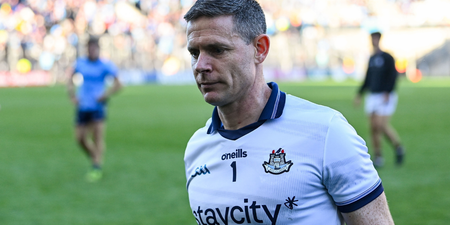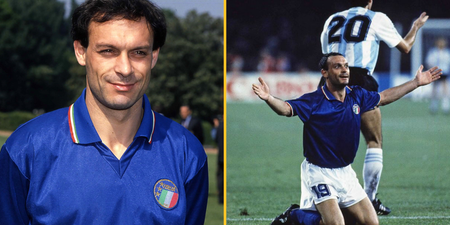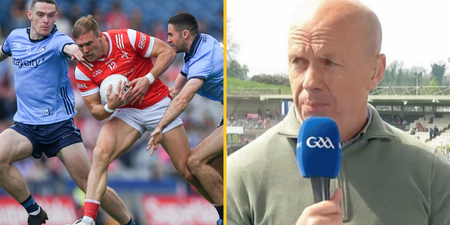This preview of the Dublin Senior Football Championship Final was written by Stephen O’Meara. You can follow him on Twitter here.
When I look at Ciarán Kilkenny, and hear much of the en vogue, negative, commentary about him, I can’t help but think of the story of Claude Makélélé, Florentíno Pérez and Real Madrid.
In fact, whenever I try to explain football on a deeper level, I find this story the most applicable to begin to get to the foundations of the understanding of Gaelic football and soccer, at their deeper theoretical core. In brief, the story goes like this.
Makélélé played three seasons for Real Madrid during which they won two La Liga titles and the Champions League.
Uninspired by his unspectacular nature, in the team of Galácticos, Real president Perez flatly refused the midfielder’s request for a pay rise and shipped him out.
“Younger players will cause him to be forgotten”, Pérez brashly stated. “He wasn’t a header of the ball, and he rarely passed the ball more than three metres”. He further stated, “ninety percent of his distribution either goes sideways or backwards”. He bought David Beckham in his place.
ICYMI: @woolberto wants to see more out of Ciarán Kilkenny. And he isn't talking about possession statshttps://t.co/UZ8AfweRCt
— GAA JOE (@GAA__JOE) September 30, 2016
When I macheted my way through the thick jungle scrub in the remotest of islands off the coast of Guinea Bissau in West Africa in 2004, where they’d barely seen a white man since the Portuguese military had left 40 years earlier, there he was, all around. Little Guinean boys, who initially legged it when they saw me, with Real Madrid shirts reading Beckham, 7, on their backs.
Perez had bought an idol. Beckham was God, on a par with Coca Cola, reaching even the most unreachable corners of the earth!
Zinedine Zidane knew better. “Why put another layer of gold paint on the Bentley when you are losing the entire engine”, he protested. Zidane understood what only those who truly understand Gaelic football, understand about Ciarán Kilkenny.
Zidane recognised that, amongst other things, Makélélé understood when it was the right time to pass forward, and more importantly, when it wasn’t.
Upon Makélélé’s departure, the most expensive team in world history slumped spectacularly. It would be 11 more seasons before they’d win their next Champions League and four more before winning La Liga.
A wily fox, Claudio Ranieri, would pick up Makélélé, the steal of the century, for £16.8 million. Under Jose Mourinho at Chelsea, Makeléle would win the next two Premier Leagues, to make it four league titles in seven years for him.
“What does it say about football if Ciarán Kilkenny wins footballer of the year”? I’ve heard it more than once in recent weeks. “Come on. He picks up easy balls, points and hand-passes the ball five or 10 yards, sideways”.
Flórentino Perez’s words ring around inside my head.
Frankly, it says everything about modern football. More and more, it has become a thinking man’s game, where those who can out-think the opposition, can outplay them. For those who understand the game at some sort of theoretical level, it’s as clear as day. For everybody else, there’s GaaProstats.
We used the GaaProstats program to crunch Kilkenny’s numbers in last week’s senior championship semi-final victory against St. Jude’s. We used two different templates to break down his possessions.
The first breaks down his basic “Possession Analysis” quantifying each ball contact. He was on the ball an immense 45 times. From this total, he turned over the ball a mere once, while trying to play a team-mate in for goal.
From the other 44, he recorded a huge 10 “Penetrative” plays (line breaks), 13 “Mildly Positive” and 21 “Neutral” plays.
Firstly, let’s make one thing clear. Relative to their respective fields, Kilkenny is a far more savvy player than Makélélé was. If Kilkenny wasn’t pointing, and playing lateral passes in the middle third, he could just as quickly be playing as a target man corner-forward, as a pivoting half-forward, as a game-controlling and man-marking centre-back, and I very much imagine, if the need arose, as a straight up man-marking corner-back.
Not alone that, I imagine that he’d do as good and maybe a better job in each of those positions than the highly accomplished Paul Mannion, Paul Flynn, Cian O’Sullivan or Davey Byrne. It’s just that Jim Gavin, who understands the game deeply, sees a higher value in him getting on the ball 40-plus times a game as standard, pointing and hand-passing the majority.
His 10 “Penetrative” plays to one turnover against St. Jude’s in the semi-final stand testament to this. By any averages, that’s a massively impressive “Positive” play to turnover ratio. That three of these accounted for scored/scoreable frees, from his brief periods in the full-forward line, stand testament to his ability as an out-and-out forward.
But what of the 21 neutral and 13 “Mildly Positive” plays? For those without a deep theoretical comprehension of the game, how can we quantify the value of these to know if he’s a Makélélé, or dare I say, a James McCarthy (Everton/Ireland, not Ballymun), who can spray passes, but seems to take the cheap, lazy and unproductive five-yard pass, when there appear to be better options.
What if you could quantify, the seemingly unquantifiable, and put a value on Kilkenny’s knowledge, even without understanding it yourself? Using the GaaProstats formula, there’s a very subtle element which alludes to this value.
We’ve looked at every passage of Castleknock possession, comparing moves which went through Kilkenny to moves which didn’t. In total, Castleknock had 48 periods of possession against St. Jude’s. Thirty of these went through Kilkenny, ranging from one to four Kilkenny possessions per move. Eighteen didn’t go through him.
Now, this isn’t a formula which you’d generally want to be use for basing conclusions on players without data from a good number of games. For example, Kilkenny could do the right thing every time, and somebody else could lose the ball in the ideal circumstances which Kilkenny created. Also, a clever player could create a score by getting out of the way. But this algorithm can certainly say if a player being in possession, even in a single given game, was a problem or not.
Basically, this algorithm alludes to the correct decision-making. If there are higher amounts of scores scored when the ball goes through a certain player, than when it doesn’t, the chances are that that player’s subtle knowledge of the game is producing more ideal attacking circumstances than average. The more games you would average these figures over, the closer you would be to calling it a scientific fact.
From the 30 moves that went through Kilkenny against Jude’s, one ended with a Castleknock side-line, one as a throw in, with six as basic turnovers and six frees in non-scoring positions. The remaining figures are startling.
Each of the remaining sixteen resulted in an attempt at a point! Five went wide, two dropped short, four went over, and five more turned into scored/scoreable frees!
That means that from a combined total of 12 Castleknock scores/scoreable frees, nine moves went through Kilkenny. From the other 18 Castleknock possessions, they scored three times!
Starting to get the picture? Castleknock had a 30% possession to score ratio on moves that went through Kilkenny, and a 17% ratio on moves that didn’t.
If Kilkenny had been awarded player of the year, what would it have said about modern football? “It is not the strongest of the species that survives, but rather, that which is most adaptable to change.”
Kilkenny is to football as the chameleon is to the jungle. Or the desert. Or the savannah. He thrives in them all.
The word genius is over-used, but I’d unreservedly use it to describe Kilkenny. He’s Gaelic football’s equivalent of Makélélé and Andrea Pirlo rolled into one.
Vincent’s won’t make a special plan for him on Saturday. They’re good enough and, deservedly, cocky enough to do what they do and not worry about the opposition. They’ve made no special plans for Dean Rock or the Brogan brothers in each of the last four years, and come out on top on each occasion. If the Brogans played at 11 and 13, they were marked by 6 and 4. If they switched to 12 and 14, they were picked up by 5 and 3.
If, however, just if, Castleknock can upset the apple cart early on Saturday’s final, a very shrewd plan B for Vincent’s would be to stick a tight man-marking corner-back on Kilkenny, where ever he goes.
All patterns suggest that stopping Kilkenny from pointing and making 10-yard lateral hand-passes would be a serious thorn in Castleknock’s side.
Who are the winners of the much-coveted 2016 Wooly Awards? Find out in our GAA Hour Special



















































